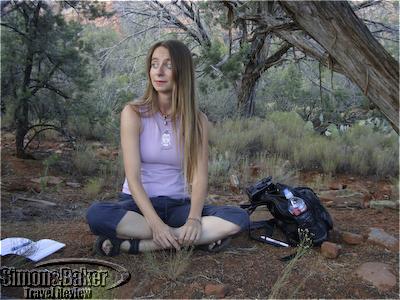Luxury Travel Review

Luxury Cape Winelands property striving for excellence
By Elena del Valle and photos by Gary Cox
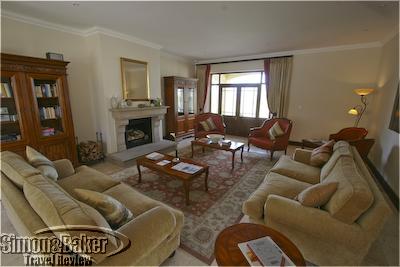
A quiet corner at Asara near the reception
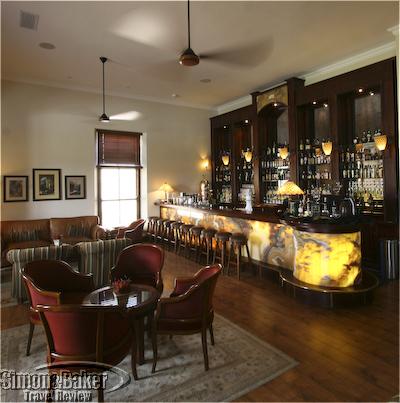
The Sansibar Cigar and Whiskey Lounge
We arrived at Asara Wine Estate and Hotel, a small luxury and gourmet oriented hotel and wine producing property just outside the college city of Stellenbosch in South Africa’s wine region, in early spring. Although there was a definite chill in the air the days were beautiful. There were just enough puffy clouds in the perfect blue sky to make it interesting and the view of the property from our rooms was lovely. It was hard to imagine that the quiet country setting was only 25 minutes away from the airport and not much further from bustling Cape Town.
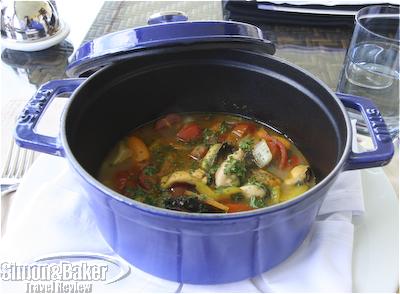
A hearty seafood lunch dish at Asara
We like that Asara is friendly to the environment. The company practices eco-sensitive biodynamic wine production to reduce the environmental impact of its operations as well as other efforts to offset the estate’s carbon footprint. Solar panels are part of the wine production process. All wine bottles and glassware on the estate are recycled.
More than 400 indigenous pin oaks trees were planted to aid oxygen production. Plans are in place to remove all alien plants from the estate by 2011. At the same time, organic waste from the restaurants and cellar is used for organic compost and the four dams in the farm are used for irrigation. No harmful chemicals are used for pest control.
Perhaps these efforts are paying off with wildlife. Recently, two new litters of endangered caracal (a fast small to medium cat similar to the serval) were seen around the estate, along with the grysbokkies, duikers and guinea fowl that the farm their home.
As a visitor what first comes to mind when I think of the 37-room Relais and Chateaux property is the view of the vineyards, a pond and mountains in the background from our table at Raphael’s, the hotel’s gourmet restaurant. We enjoyed the comfortable and well appointed accommodations and facilities and food and wine opportunities and would gladly return. Click here to read about our visit to Asara.
Savannah for a unique blend of antebellum charm, 21 century creativity
Article and photos by Josette King
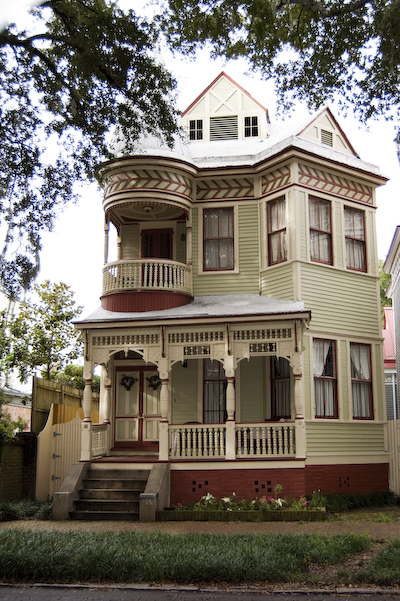
It is said in Savannah that when its founder General James Oglethorpe departed for England in 1743 he left instructions not to change anything until he returned. He never did. And although the city expanded in the centuries that followed, it retained the grid pattern of verdant squares linked by broad avenues envisioned by Oglethorpe. Today, under its iconic canopy of ancient live oaks fluttering with Spanish moss, Savannah remains a languid antebellum city of elegant colonial mansions and Southern charm.
But while history resonates at every turn, so does the creative energy of the city’s art scene stimulated by the students, faculty and alumni of the booming Savannah College of Art and Design (SCAD). Their inspiration is very much in evidence at the college’s own store, shopSCAD (300 Bull Street). This unique emporium is bursting with cutting-edge paintings, photographs, pottery, jewelry and wearable items; reasonably priced creations of the students, faculty and alumni of the college.
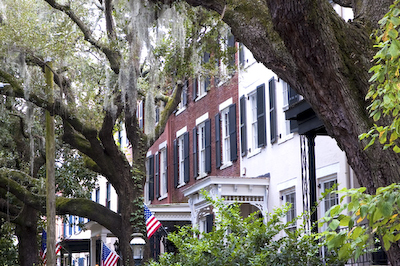
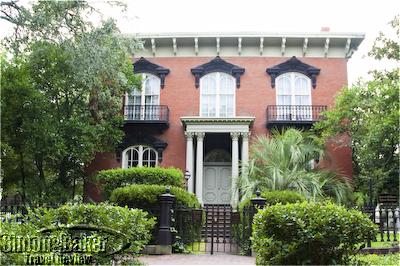
Creativity spills over into other areas of the city’s life as well. Young chefs put their own original spin on Southern classics and old favorites from around the world that have settled over time in the historic port city of Savannah. I enjoyed several lovely meals during my recent visit, most notably a dinner at Local 11ten (1110 Bull Street). Since he took over the kitchen in early 2008, Chef Jeff Rodgers has worked closely with a handful of trusted small suppliers to source the best locally grown and harvested products he showcases in his refined yet unpretentious menu.

Scallops seared to perfection at Local 11ten
And word has been spreading that something wonderful is happening at Local 11ten. A friend who had recently visited Savannah recommended it, “and make sure to try the scallops,” he said. I did. The four gigantic sea scallops were so fresh and sweet they required only the slightest bit of searing. They were served on a bed of crisp asparagus and barely wilted endive, drizzled with a warm sweet pepper vinaigrette, their tartness the perfect foil for the sweetness of the scallops. But equally palate-thrilling were the amuse-bouche: a generously-sized lobster cake served with a glaze of horseradish and sherry sauce. We unanimously declared it worthy to become one of Chef Rodgers’ signature dishes.
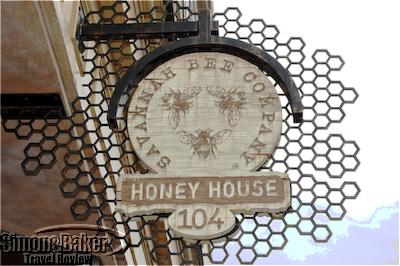
For creativity in retailing, my personal award goes to the Honey House (104 Broughton Street). Opened in 2008 as the flagship store of a local artisanal honey producer, the Savannah Bee Company, this Historic District storefront has already established itself as a required stop for local and visiting gourmets and other discriminating shoppers. The shop was a visual feast, brimming with artfully arranged displays of all things honey. The company’s signature tapered bottles lined the walls, filled in many shades of gold, from deep sourwood to rich tupelo to pale acacia honey and several hues in between.
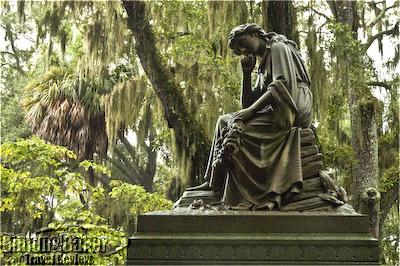
The stacks of body-care offerings were equally irresistible, from Royal Jelly body butter to bees wax and nail salve and mint julep lip balm. Deeper into the store a floor to ceiling hive playroom invited children to pretend they were bees, while adults browsed the tempting array of bee themed toys and children’s clothing. Bee-keeping jumpsuits, hats and other paraphernalia were also available. Feeling weak from so many choices, I repaired to the bar for a honey cappuccino and honey tasting (the full-bodied Tupelo honey was my favorite), but for me the ultimate indulgence was the honeycomb sampling tray. Who would have thought a sliver of honeycomb on a slice of sharp cheese, or tart green apple, could taste to wonderful?
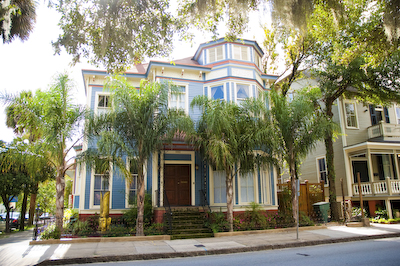
The Waldburg, a charming Queen Anne home overlooking the park
Meanwhile, there is also much happening on the architectural preservation front, which is gaining momentum around Forsyth Park, Savannah’s Central Park at the southern edge of the Historic District. This is the Victorian District where graceful 19th Century houses overlooked for decades are now being painstakingly brought back to their original loveliness. I had the pleasure to stay in one of them during my visit to Savannah: The Waldburg, a charming Queen Anne house overlooking the park.
It was recently the object of a thoughtful renovation into two elegant vacation apartments, clearly with the comfort and enjoyment of their guests in mind. Conveniently located within walking distance from many of the most sought-after tourist attractions in Savannah, it was an ideal base from where to experience the gracious essence of this most Southern of cities. Click here to read more about my recent visit to Savannah, and my most enjoyable stay at The Waldburg.
Film explores community oriented conservation issues facing Africans
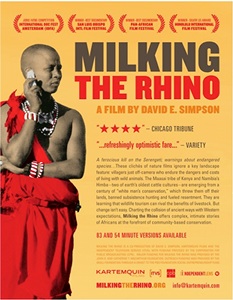
Milking the Rhino
One of the biggest challenges facing conservation minded individuals and organizations in Southern and Eastern Africa is native populations and their cultural dislike, even hatred, of predators. While many animals live within protected areas such as national parks and private reserves others compete for natural resources and land with local populations. As the number of animals and the genetic diversity dwindles Africans face some difficult choices for the long term: Share existing resources in spite of their attitudes toward the animals or, eventually, lose what is left of the once abundant predator populations.
Even if cattle are considered their prime source of wealth should tribal leaders as well as local and national governments strive to protect resources including predators which have historically been considered worthless or worse, enemies, for many indigenous peoples? What are the possible benefits and detriments of these policies? What is the best way to go about implementing them and much time will it take to see the results?
In Milking the Rhino, filmmaker David E. Simpson dedicated an 83-minute documentary, released in 2008, to exploring the topic. For this purpose he and his team traveled to Kenya and Namibia where they spoke with and interviewed local tribe members and leaders about conservation issues and how they are dealing with them. Of four locations his team explored initially they selected two for filming Il Ngwesi in Kenya and Marienfluss Conservancy in Namibia. Both groups are cattle centric yet wishing to learn to exploit their natural resources to expand their economies.
“Most of the conservation world is now of the consensus that for wildlife to survive and to do well in a meaningful way, there has to be some stake in its survival there has to be some stake for people rural people, who live amongst them,” said Simpson who believes many people in the northern hemisphere still rely on the outdated fortress model of building fences around a reserve as a means of conservation.
There was a lot of pre-production work for the film, especially in Namibia due to extensive paperwork (visa and film permits) requirements and a high percent of remote filming locations. Some of the locations were three day’s drive from the main city and had little to no electricity, requiring the team to be self sufficient and rely on their own camping gear.
“There are a lot questions about whether those two places (portrayed in the film) will work. So, it’s by no means sure that this is a formula that can be prescribed successfully. But what we did feel in terms of a sense of hopefulness, was that there were some really, really commited people, like our two main characters, John and James, who are passionate and commited and smart and are going to try and make things work for these communities in our film,” said Simpson.
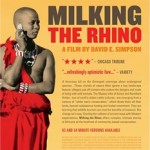
Click here to buy Milking the Rhino
Grand Canyon train ride fun side trip from Sedona
Article by Elena del Valle and photos by Amparo Cadavid
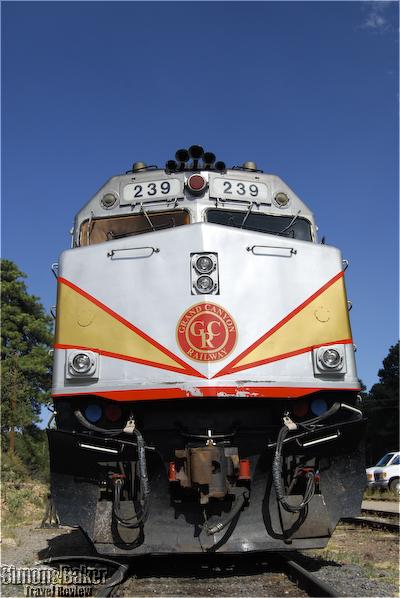
Grand Canyon Railway
Although Sedona had plenty of worthy attractions and we were enjoying the local sites, the allure of the Grand Canyon was irresistible so we dedicated one day of our week long visit to Sedona to that majestic area. Instead of making the round trip drive from Sedona to the Canyon’s South Rim at an elevation of 7,000 feet, we chose to ride the Grand Canyon Railway (233 N. Grand Canyon Blvd, Williams, Arizona 86035; www.thetrain.com, info@thetrain.com,1-800-THE-TRAIN). The train departed from the small town of Williams, about one hour drive north of Sedona.
We set out about 7:30 a.m. down a pretty canyon road from Sedona to meet up with the highway (Interstate 17) that led us to Williams; and returned to Sedona at 7 p.m. just in time for dinner. Parking was easy once we found the train station and we boarded the train on time for the daily 9:30 a.m. departure. The train, pulled by a diesel engine, traveled at 40 miles per hour over 65 miles and could accommodate up to 700 passengers in nine cars offering varying degrees of comfort.
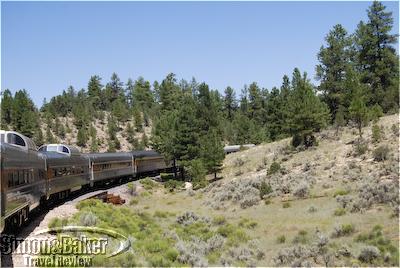

Grand Canyon Railway Luxury Parlor Car
Our Luxury Parlor Car, Chief, was the last and most luxurious on the train and to our delight it was only half full on the midweek August day we traveled, allowing us to spread out comfortably. There was a wood bar and a spacious water closet in the middle of the car. At the back, there was an open air platform for up to six people at a time to enjoy the outdoor sights and sounds. The platform was our favorite part of the train.
Our car was manned by Attendant Katie McKinnon and Christine, a trainee. They kept us informed, opened the complimentary small buffet (mini muffins, fruit salad, yogurt and apples) and served drinks including complimentary coffee (and champagne on our return). On the way there, we were assigned seats 21D and 23D at the back of the car. The two-and-a-half hour train ride passed quickly and soon we arrived at the Grand Canyon where we had three hours to explore on foot, take a bus tour or have lunch. While it was possible to have a sit down lunch at one of the local restaurants we were there to see the Grand Canyon and since we had limited time we preferred to explore the sites.
We chose to walk along the paved hiking path, following Katie’s recommendations, and have a quick bite at the cafeteria before returning to the train for our ride home. Since we were returning to Williams that same day we were invited to leave any belonging we didn’t require for our visit to the park on board our train car. This was very convenient since it was the middle of a hot summer day and we planned to walk for the better part of three hours.
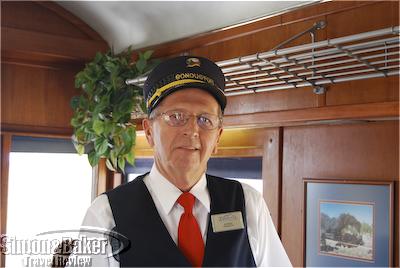
Our train conductor
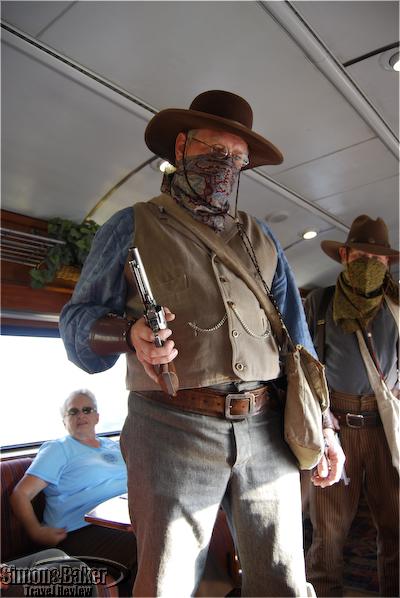
A train "robbery"
Before boarding there was a “shoot out” which we missed due to a slight delay finding our way to the station. On the way back the train was “held up” by “robbers.” Also, Craig Summers, a native of Jacksonville, Florida played his guitar and sang country songs during the train ride, moving from car to car along the way. The Grand Canyon Railway, now owned by Xanterra Parks and Resorts, began operations in 1901.
Our day trip to the Grand Canyon South Rim was entertaining and relaxing at the same time. Making the round trip trek on Grand Canyon Railway rather than driving was the perfect solution to our time limitation and desire to visit the Grand Canyon for the day. The next time, maybe we’ll spend the night at the park and enjoy the sunrise and sunset or be adventurous and journey to the depths of the Canyon on mules.
Sedona dosha experience promoted self awareness
By Elena del Valle and photos by Amparo Cadavid
We met Patricia Fonseca, a dosha instructor with a bright smile and a friendly demeanor, at the lobby of our hotel late one afternoon during a visit to the town of Sedona, Arizona for a late afternoon Dosha Tour (it proved to be more of an exploration). We were intrigued by the general idea of doshas although we knew little about the details. Since the town is well known for its vortexes (energy centers) and appeal to adepts of the spiritual arts discovering our dosha type seemed appropriate. Doshas are Ayurveda mind and personality profiles; Ayurveda is the Indian concept of living in harmony with nature.
From our hotel in downtown Sedona we drove to the Buddhist Stupa, a place for meditation and contemplation, a few minutes south on Arizona State Route 89A. Once there, we each circled the statue of Buddha thrice in a clockwise direction before settling in Patricia’s “secret place,” a quite corner in the nearby brush. We began by completing a short dosha written questionnaire which addressed our physical characteristics, behavior, and eating habits among other things.
Patricia, who is also a yoga instructor and attorney, discussed the results with us and explained the characteristics of each of the three doshas: Vata (air and ether), Pitta (fire with water) and Kapha (water and earth). She shared daily lifestyle and dosha specific recommendations for meditation, exercise, eating and bathing such as sleeping well enough to wake up on your own (rather than to the sounds of an alarm clock), brushing your teeth and using sesame, coconut or mustard oil in your bathing ritual depending on your mood. We concluded our private two-hour session with a few minutes of Circle Breath of Life meditation in the half light of the early evening. Discovering our dosha profile was fun and expanded our self awareness.

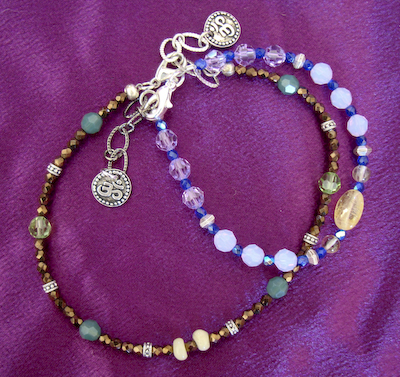
Patricia, who has been teaching Ayurvedic Yoga and offering dosha consultations for eight years, studied with an Ayurvedic teacher for five years and upgrades her knowledge through self study. While we were with Patricia we noticed a pretty stone and Swarovski crystal necklace she was wearing and complimented her on it. The Sedona resident explained it is part of Dosha Designs, a line of jewelry she created to match the color and mood preferences of each the three doshas.
She matches earth and forest tones (amethyst and opals) for Vata, ocean colors (tourmaline and fluorite) for Pitta and vibrant colors such as purple and pastel tones (garnet and citrine) for Kapha types. The earrings, bracelets and necklaces were sold at Sedona Rouge, a local hotel. She hopes to offer a selection online in the coming months.
The Dosha Tour, available for the past three years, was booked through Sedona Red Rock Tours (P.O. Box 4074 Sedona, Arizona 86340, 928-282-0993 and 928-274-1323, www.sedonaredrocktours.com, and sedonaredrocktours@gmail.com).
Sedona, soothing for the soul
Article by Elena del Valle, photos by Amparo Cadavid
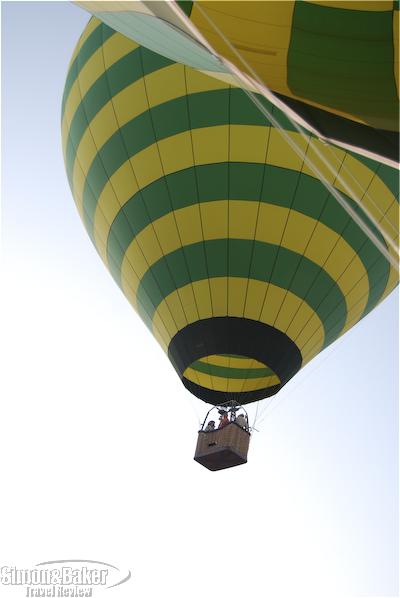
A hot air balloon near Sedona
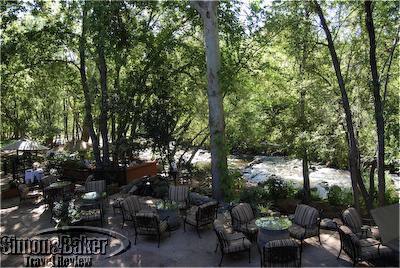
Outdoor dining at L'Auberge de Sedona
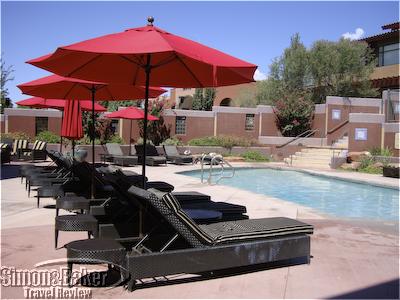
The pool area at Sedona Rouge
Sedona, a small town in northern Arizona known mostly for its red rocks and energy centers or vortexes, proved to be as pretty as we had heard. Although it is a highly touristy area in the low summer season when we were there its natural charms easily outweighed the drawbacks of a tourism driven area.
When we were there it was quiet, serene, uncrowded and pretty. Its magnificent red rocks were reason enough to draw us there and its lovely setting, crime free and clean environs made fans of us eager to return. We liked the accommodations at L’Auberge de Sedona and Sedona Rouge.
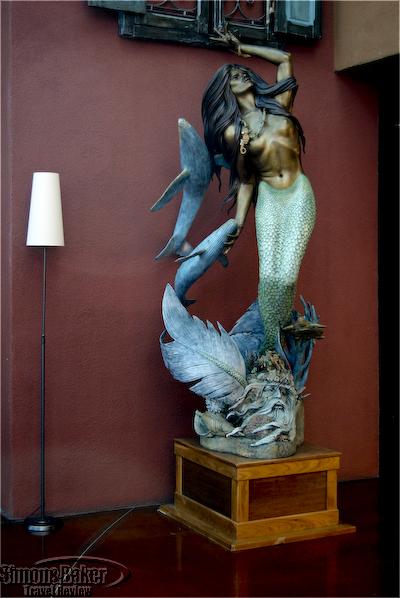
A mermaid at Sedona Rouge
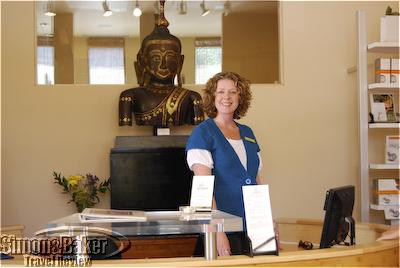
Guests at L'Aubege de Sedona were welcome at Amara Spa
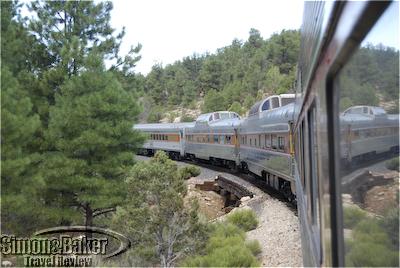
On our way from Sedona to the Grand Canyon
Among our favorite activities were hiking the rocks, discovering the creeks, listening to flute players such as Jesee Kalu, a midday meal at the ChocolaTree (especially the guacamole), creek side dining at L’Auberge de Sedona restaurant, and early morning time at our L’Auberge de Sedona cottage outdoor deck.
We also enjoyed time at the Sedona Rouge Spa, a day long train ride to the Grand Canyon on the Grand Canyon Railway, a dosha type session by the Buddha Stupa, a dawn balloon ride with Northern Light Balloon Expeditions and a fun and thought provoking astronomy session with Dennis Young hosted by our hotel. Click here to read more about our visit to Sedona.

